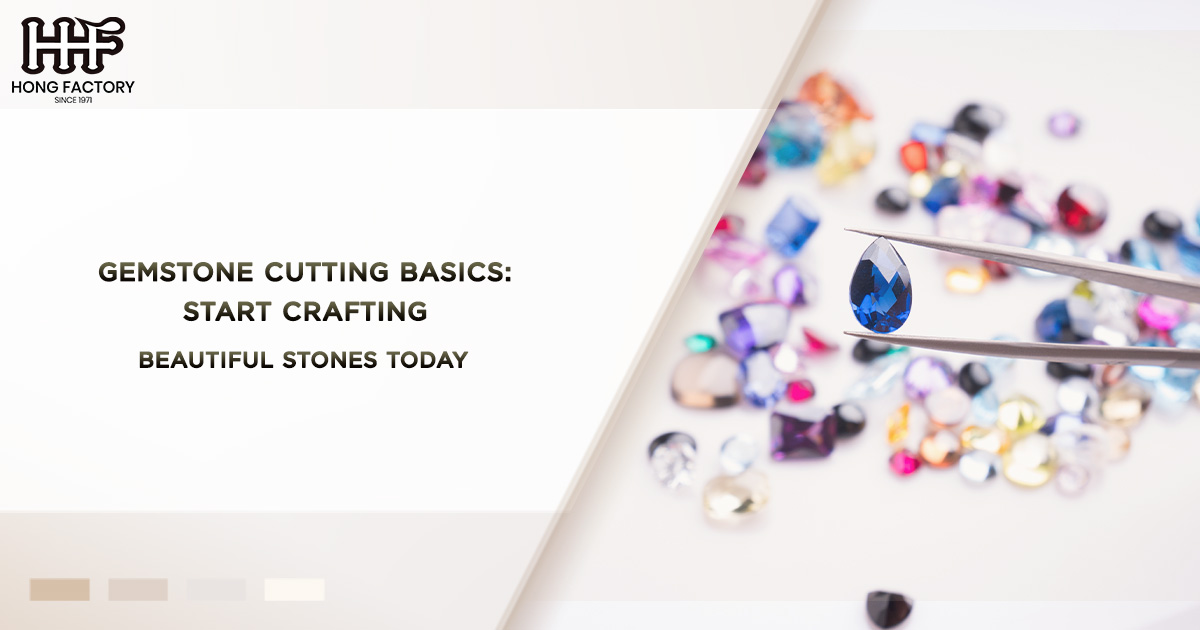Gemstone cutting, an art known as lapidary, transforms raw stones into stunning pieces of jewelry. Whether you are a beginner or looking to refine your skills, understanding the basics of gemstone cutting is essential. In this article, we will explore the basic cuts, tool usage, safety measures, and stone selection to help you start crafting beautiful stones today. By incorporating these elements, you can enhance your lapidary skills and create polished gemstones with precision and artistry.
Basic Cuts
Understanding the different cuts is fundamental in lapidary, as each type can enhance the stone’s natural beauty in unique ways. Here are some of the most common cuts to get familiar with:
- The brilliant cut, typically used for diamonds, is known for its exceptional sparkle. This cut features numerous facets that maximize the stone’s light reflection, making it one of the most popular choices for transparent gemstones.
- The cabochon cut involves shaping the stone into a smooth, rounded dome. This cut is ideal for opaque and translucent stones, such as opals and turquoise, as it highlights the stone’s color and pattern without focusing on internal clarity.
- The step cut features rectangular or square facets arranged in steps. Common in emeralds, this cut emphasizes color over brilliance, making it suitable for stones with rich hues and clarity.
- With a flat base and a domed top covered in triangular facets, the rose cut enhances the stone’s surface sparkle. It’s a vintage style that is gaining renewed interest among jewelers and collectors.
- Combining elements from different cuts, the mixed cut allows lapidaries to balance brilliance and color. It’s often used for gemstones that benefit from both a brilliant top and stapled sides.
Tool Usage
To achieve precision in gemstone cutting, using the right tools is crucial. Each tool serves a specific purpose in the lapidary process, from cutting to polishing the stones.
Essential Equipment
- Trim Saw : Used to cut rough stones into manageable sizes. Equipped with a diamond blade, this saw can handle various types of gemstones.
- Faceting Machine : A must-have for achieving precise cuts, a faceting machine allows you to create symmetrical facets on a stone. It consists of a grinding wheel and a dop stick, which holds the stone in place.
- Cabochon Machine : Specifically designed for creating cabochon cuts, this machine typically includes multiple wheels for grinding, sanding, and polishing the stone into a smooth dome.
- Dop Station : Used to adhere stones to a dop stick with wax or glue, ensuring stability during cutting and polishing.
- Polishing Equipment : Polishing wheels or discs, often coated with diamond paste or other polishing compounds, bring the final shine to the stone.
Tool Maintenance
Proper maintenance of your equipment is vital for both performance and safety. Regularly clean and inspect your tools to ensure they function correctly and safely. Replace worn-out blades and wheels as needed to maintain cutting efficiency and accuracy.
Safety Measures
Lapidary work involves various tools and processes that can be hazardous without proper precautions. Following safety measures helps prevent injuries and ensures a safe working environment.
Personal Protective Equipment (PPE)
– Safety Goggles: Protect your eyes from dust, debris, and potential fragments during cutting and grinding.
– Dust Mask: Use a dust mask or respirator to avoid inhaling fine stone particles, which can be harmful over time.
– Gloves: Wear gloves to protect your hands from cuts and abrasions, though be cautious to avoid getting them caught in moving machinery.
– Hearing Protection: Some equipment can be loud, so ear protection may be necessary to prevent hearing damage.
Ventilation
Ensure your workspace is well-ventilated to disperse dust and fumes generated by cutting and polishing gemstones. Consider using a dust collection system to minimize airborne particles.
Handling Equipment
Handle all tools and equipment with care. Always follow the manufacturer’s instructions for each device, and never bypass safety features. Keep work areas clean and organized to avoid accidents.
Stone Selection
Choosing the right stone is essential for successful lapidary work. The selection process involves assessing the stone’s properties and suitability for the desired cut and application.
Types of Gemstones
– Hardness: Consider the Mohs scale of hardness for the stone. Softer stones are easier to cut but may scratch easily, while harder stones require more durable equipment.
– Color and Clarity: Evaluate the color and clarity of the stone. Brightly colored stones with minimal inclusions typically yield the most visually appealing results.
– Size and Shape: Select stones that are large enough to accommodate the desired cut. Irregular shapes may limit your options and require more intricate planning.
– Rarity and Value: Some stones have unique properties or are rare, affecting their value. Consider both the aesthetic and monetary value when selecting stones for your projects.
Sourcing Gemstones
Sourcing high-quality gemstones is crucial for achieving beautiful cuts. Develop relationships with reputable dealers and suppliers who offer certified stones. Attend gem and mineral shows to explore different types of stones and gain inspiration for your work.
Testing and Preparation
Before cutting, thoroughly inspect your chosen stone for fractures or weak points that could affect the cutting process. Use a loupe or magnifying glass for a detailed examination and mark any areas to avoid.
Conclusion
By understanding the basics of gemstone cutting, including the types of cuts, proper tool usage, safety measures, and stone selection, you can embark on your lapidary journey with confidence. With practice and patience, you can transform raw gemstones into stunning pieces that highlight their natural beauty and uniqueness. Whether crafting for personal enjoyment or professional endeavors, mastering these foundational skills will set you on a path to creating captivating jewelry pieces that resonate with elegance and precision.
